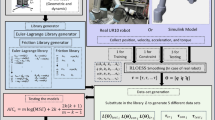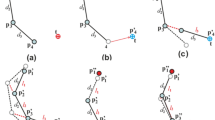Abstract
In this paper, we present a model for the inverse dynamics of underactuated manipulators that is free from inertial coupling singularities. The framework’s main idea is to include a small-amplitude wave on the trajectory of the rotating active joints. First, we derive the modified nonlinear dynamics for the multijoint manipulators with multiple degrees-of-freedom (DoF). Next, a 4-DoF mass-rotating underactuated manipulator with two passive and two active joints is chosen. Then, a condition assuming the positive definiteness of the inertia matrix is developed to have the singularity-free inverse dynamics. Finally, we analytically study how singularities can be avoided and show an example simulation with a feed-forward control at the singular configuration.










Similar content being viewed by others
Notes
Please, check Proposition 1 for the details of parameter design.
References
Agrawal, S.K.: Inertia matrix singularity of planar series-chain manipulators. In: IEEE International Conference on Robotics and Automation, pp. 102–107 (1991)
Albahkali, T., Mukherjee, R., Das, T.: Swing-up control of the Pendubot: an impulse–momentum approach. IEEE Trans. Robot. 25(4), 975–982 (2009)
Altmann, R., Betsch, P., Yang, Y.: Index reduction by minimal extension for the inverse dynamics simulation of cranes. Multibody Syst. Dyn. 36(3), 295–321 (2016)
Arai, H., Tachi, S.: Position control of manipulator with passive joints using dynamic coupling. IEEE Trans. Robot. Autom. 7(4), 528–534 (1991)
Bastos, G., Seifried, R., Brüls, O.: Inverse dynamics of serial and parallel underactuated multibody systems using a DAE optimal control approach. Multibody Syst. Dyn. 30(3), 359–376 (2013)
Bellino, A., Fasana, A., Gandino, E., Garibaldi, L., Marchesiello, S.: A time-varying inertia pendulum: analytical modelling and experimental identification. Mech. Syst. Signal Process. 47(1–2), 120–138 (2014)
Bergerman, M., Lee, C., Xu, Y.: A dynamic coupling index for underactuated manipulators. J. Robot. Syst. 12(10), 693–707 (1995)
Blajer, W., Seifried, R., Kołodziejczyk, K.: Servo-constraint realization for underactuated mechanical systems. Arch. Appl. Mech. 85(9), 1191–1207 (2015)
Chenarani, H., Binazadeh, T.: Flexible structure control of unmatched uncertain nonlinear systems via passivity-based sliding mode technique. Iran. J. Sci. Technol. Trans. Electr. Eng. 41(1), 1–11 (2017)
Eom, M., Chwa, D.: Robust swing-up and balancing control using a nonlinear disturbance observer for the Pendubot system with dynamic friction. IEEE Trans. Robot. 31(2), 331–343 (2015)
Fevre, M., Goodwine, B., Schmiedeler, J.P.: Terrain-blind walking of planar underactuated bipeds via velocity decomposition-enhanced control. Int. J. Robot. Res. 38(10–11), 1307–1323 (2019)
Freidovich, L., Robertsson, A., Shiriaev, A., Johansson, R.: Periodic motions of the Pendubot via virtual holonomic constraints: theory and experiments. Automatica 44(3), 785–791 (2008)
Gandino, E., Marchesiello, S., Bellino, A., Fasana, A., Garibaldi, L.: Damping effects induced by a mass moving along a pendulum. Shock Vib. 2014, 314527 (2014)
Jafari, R., Mathis, F.B., Mukherjee, R.: Swing-up control of the Acrobot: an impulse-momentum approach. In: Proceedings of the 2011 American Control Conference, pp. 262–267 (2011)
Liu, Y., Yu, H.: A survey of underactuated mechanical systems. IET Control Theory Appl. 7(7), 921–935 (2013)
Ramasamy, S., Wu, G., Sreenath, K.: Dynamically feasible motion planning through partial differential flatness. In: Robotics: Science and Systems (2014). Citeseer
Spong, M.W.: Partial feedback linearization of underactuated mechanical systems. In: Proceedings of IEEE/RSJ International Conference on Intelligent Robots and Systems, vol. 1, pp. 314–321 (1994)
Spong, M.W.: The swing up control problem for the Acrobot. IEEE Control Syst. Mag. 15(1), 49–55 (1995)
Spong, M.W.: Energy based control of a class of underactuated mechanical systems. IFAC Proc. Vol. 29(1), 2828–2832 (1996). 13th World Congress of IFAC
Spong, M.W., Block, D.J.: The pendubot: a mechatronic system for control research and education. In: Proceedings of 1995 34th IEEE Conference on Decision and Control, vol. 1, pp. 555–556 (1995)
Stilling, D.S., Szyszkowski, W.: Controlling angular oscillations through mass reconfiguration: a variable length pendulum case. Int. J. Non-Linear Mech. 37(1), 89–99 (2002)
Ströhle, T., Betsch, P.: Solution techniques for problems of inverse dynamics of flexible underactuated systems. In: European Congress on Computational Methods in Applied Sciences and Engineering, pp. 131–138. Springer, Berlin (2019)
Svinin, M., Goncharenko, I., Luo, Z.W., Hosoe, S.: Reaching movements in dynamic environments: how do we move flexible objects? IEEE Trans. Robot. 22(4), 724–739 (2006)
Tafrishi, S.A., Bai, Y., Svinin, M., Esmaeilzadeh, E., Yamamoto, M.: Inverse dynamics-based motion control of a fluid-actuated rolling robot. Russ. J. Nonlinear Dyn. 15(4), 611–622 (2019)
Tafrishi, S.A., Svinin, M., Esmaeilzadeh, E., Yamamoto, M.: Design, modeling, and motion analysis of a novel fluid actuated spherical rolling robot. J. Mech. Robot. 11(4), 041010 (2019)
Tafrishi, S.A., Svinin, M., Yamamoto, M.: Singularity-free inverse dynamics for underactuated systems with a rotating mass. In: IEEE International Conference on Robotics and Automation (ICRA), pp. 3981–3987 (2020)
Tedrake, R.: Underactuated robotics: learning, planning, and control for efficient and agile machines course notes for MIT 6.832 (2009)
Yabuno, H., Matsuda, T., Aoshima, N.: Reachable and stabilizable area of an underactuated manipulator without state feedback control. IEEE/ASME Trans. Mechatron. 10(4), 397–403 (2005)
Zhang, M., Tarn, T.J.: A hybrid switching control strategy for nonlinear and underactuated mechanical systems. IEEE Trans. Robot. Autom. 48(10), 1777–1782 (2003)
Acknowledgements
This research was supported, in part, by the Japan Science and Technology Agency, the JST Strategic International Collaborative Research Program, Project No. 18065977.
Author information
Authors and Affiliations
Corresponding author
Ethics declarations
Conflict of interest
The authors declare that they have no conflict of interest.
Additional information
Publisher’s Note
Springer Nature remains neutral with regard to jurisdictional claims in published maps and institutional affiliations.
Supplementary Information
Below is the link to the electronic supplementary material.
Appendix A: Dynamics of the 4-DoF manipulator
Appendix A: Dynamics of the 4-DoF manipulator
We show the 4-DoF nonlinear dynamics of a manipulator by the derived general formulation in Sect. 3.
In our study, we consider our system with two passive and two active joints. The active joints on the second and forth links have the wavy trajectory with variables \(\{a_{2},n_{2},\varepsilon _{2}\}\) and \(\{a_{4},n_{4},\varepsilon _{4}\}\). The passive joints in the first and third links do not have the wave functions \(a_{1}=n_{1}=\varepsilon _{1}=0\) and \(a_{3}=n_{3}=\varepsilon _{3}=0\). So for the considered system, the Lagrangian function in (10) becomes
Furthermore, by using equation (28) and the Lagrangian equations (11), the motion equation terms of (12) become
where
Additionally, the velocity dependencies and gravitational terms \(h_{k}\) in each link are obtained by using (13) as
and
Rights and permissions
About this article
Cite this article
Tafrishi, S.A., Svinin, M. & Yamamoto, M. Inverse dynamics of underactuated planar manipulators without inertial coupling singularities. Multibody Syst Dyn 52, 407–429 (2021). https://doi.org/10.1007/s11044-021-09788-8
Received:
Accepted:
Published:
Issue Date:
DOI: https://doi.org/10.1007/s11044-021-09788-8




